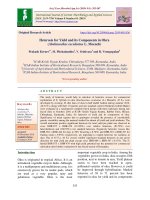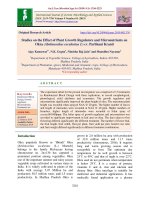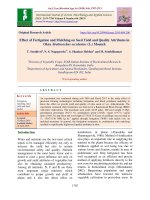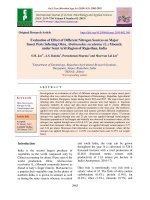Appraisement of yield and seed production of okra (Abelmoschus esculentus L. Moench) cv. arka anamika at varying sowing dates
Bạn đang xem bản rút gọn của tài liệu. Xem và tải ngay bản đầy đủ của tài liệu tại đây (296.05 KB, 9 trang )
Int.J.Curr.Microbiol.App.Sci (2020) 9(5): 486-494
International Journal of Current Microbiology and Applied Sciences
ISSN: 2319-7706 Volume 9 Number 5 (2020)
Journal homepage:
Original Research Article
/>
Appraisement of Yield and Seed Production of Okra (Abelmoschus
esculentus L. Moench) cv. Arka Anamika at Varying Sowing Dates
D. K. Upadhyay1*, R. K. Singh2 and T. Chaubey2
1
Department of Genetics and Plant Breeding, Rani Lakshmi Bai Central Agricultural
University, Jhansi-284003 (U.P.), India
2
ICAR-Indian Institute of Vegetable Research, Varanasi-221305 (U.P.), India
*Corresponding author
ABSTRACT
Keywords
Okra, Arka
Anamika, Fruit
yield, Seed yield,
Variety
Article Info
Accepted:
05 April 2020
Available Online:
10 May 2020
Field trials were conducted to evaluate green fruit and seed production of okra (Abelmoschus
esculentus L. Moench) cv. Arka Anamika at varying sowing dates The experiment was conducted at
ICAR-Indian Institute of Vegetable Research, Varanasi (U.P.) during spring summer season from
January to May 2014 to find out the appropriate sowing date for yield and seed production of okra
cultivar Arka Anamika. Five sowing dates viz. 20th January (T1), 30th January (T2), 09th February
(T3), 19th February (T4) and 01st March (T5) were used as treatment variables. Observation were
taken 30 days after sowing (DAS) at every 20 days interval for study of different morphological
traits. From the results obtained, it can be concluded that the optimal sowing date for okra variety
Arka Anamika would be first week of March for prominent yield and seed production. Seed yield is
correlated with the performance of yield contributing attributes and a perusal of data pertaining to
seed yield components viz. number of flowers/plant, number of pods/plant, diameter of fruit, weight
of fruit, fruit length, and number of seeds/pod revealed that the environment was more favorable for
okra variety Arka Anamika. The higher germination percentage and seed vigour index was recorded
from 19th February and 1st March sowing because the matured pods faced less amount of rainfall
during their harvesting period, resulting to more production of bold seeded pods at that time. It was
produced prominent yield and seed production when the crop was sown on 1 st week of March which
was found superior in seed yield and its components over rest of the sowing dates.
secondary centre of origin (Gopalakrishnan
and Peter, 2007). In India, it is grown for its
tender green fruits during spring-summer with
rainy season and it’s used by people in
different ways; immature pods are consumed
as boiled vegetables; also dried and used as
soup thickeners or in stews, which are rich
sources of vitamins, calcium, potassium and
other minerals. Okra is a nutritious vegetable
which plays an important role to meet the
Introduction
Okra (Abelmoschus esculentus L. Moench) is
an important vegetable crop in tropical and
subtropical parts of the world. It is a
semiwoody, fibrous, herbaceous annual plant
with an indeterminate growth habit (Balock,
1994). Existence of a large number of related
species with wide variability and dominant
characters suggest possible role of India as a
486
Int.J.Curr.Microbiol.App.Sci (2020) 9(5): 486-494
demand of vegetables of the country when
vegetables are scanty in the market.
formation. A previous report suggested that
sowing date play an important role in growth
and pod formation (Randhawe, 1967, Ali et
al., 2019).
The yield could reach as high as 30 t/ha
(Koay and Chua, 1978). The unavailability of
quality seed and heavy incidence of biotic
stresses particularly yellow vein mosaic virus
(YVMV) are the most important reasons for
low yield. The disease YVMV transmitted by
the whitefly (Bemisia tabaci) is reported to be
one of the most destructive plant diseases in
India causing great loss by affecting quality
and yield of fruits, as high as 93.80%
depending on age of plant at the time of
infection (Sastry and Singh, 1974). Sowing
time has a great impact on seed production
and quality of okra (Singh et al., 1986;
Hossain et al., 1999; Yadav and Dhankar
2001; Moniruzzaman et al., 2007). Besides,
the time of seed sowing has a direct bearing
on the incidence of YVMV disease in eastern
India. Different environmental factors during
seed production can influence seed yield and
quality. It is very likely that with the
increased critical approach to seed quality
required for modern methods of vegetable
production, we will have to make a greater
distinction between seed quality and seed
yield during the field multiplication of a
cultivar. Adetunji and Chheda (1989)
suggested that where limited resources
prevent the use of several locations, different
dates of planting for two or more years could
be used to evaluate okra varieties for seed
yield without losing much information on
their relative ranking. Different cultivars
require different climatic condition as well as
different sowing time and a good cultivar
sown at improper time to give poor yield.
Both quantitative and qualitative traits of
crops depend on sowing date and growing
season. Determination of optimum sowing
date is considered an important effort to have
optimum yields. Okra sowing date as a factor
affecting plant growth and yield depends on
the prevailing environmental conditions
especially temperature and relative humidity.
Optimum temperature, low relative humidity
and low rain fall during seed maturity resulted
in higher yields of quality seed of cotton and
some vegetables (Delouche, 1980), whereas,
high temperature and humidity increased
susceptibility of seed to fungal diseases. Okra
requires warm to hot weather conditions
(23°C-37° C) for optimum growth and yield.
Time to flowering and duration of growth
strongly influences the climatic adaptation
and yield potential of a crop. Variations in
both relative humidity and temperature
affected both okra growth and flower
production (Dilruba et al., 2007, Sonu et al.,
2013, Elhag and Ahmad, 2014). Keeping in
view, the present experiment was conducted
to find out the suitable sowing date to
determine better yield and seed production of
Okra.
Materials and Methods
The experiment was carried out at ICARIndian Institute of Vegetable Research,
Varanasi (U.P.) during spring summer season
from January to May 2015. The cultivar Arka
Anamika of okra is sown in an area of 109.2
m2 and divided into 20 plots having the size
of 1.8 m × 1.25 m each and arranged in the
four replications. The experiment was laid out
in Randomized Block Design with 5
treatments. Before starting the experiment, the
representative soil status were taken randomly
In okra flower and bud drop before pod set
are the major problems when the temperature
is fluctuating and rises above 95°F.
Pollination is poor if temperature raises above
90°F and drop below 55°F, also low intensity
water stress and excess nitrogen inhibit pod
487
Int.J.Curr.Microbiol.App.Sci (2020) 9(5): 486-494
at depth of 15 cm and analyzed for physical
and chemical status. It was texturally
classified as sandy loam soil and slightly
alkaline in nature, has available N2 110.50
Kg/ha, P2O5 40.50 Kg/ha, K2O 190.40 Kg/ha,
Organic carbon 0.12 % with a pH of 8.6.
analysis of variance technique for RBD
(Randomized Block Design) and the graph
was prepared by using Microsoft excel.
Results and Discussion
The results of response of okra variety Arka
Anamika to different sowing dates showed
significant variations. Plant height was
significantly affected by sowing dates, the
maximum height of plant at 30 DAS, was
recorded in the treatment T5 (1st March) with
13.87 cm, 50 DAS with 22.99 cm and 70
DAS with 39.29 cm, whereas in all
subsequent days after sowing minimum
height of plant were observed in T1 (20th
January) (fig.1). For the proper growth of
plant legitimate environment like temperature,
soil moisture and good air movement etc. are
required. Similar were made by Elhag and
Ahmed (2014), Ossom and Kunene (2011).
The experimental field was ploughed to make
the soil fine tilth up to a depth of 15-20 cm
with the help of disc plough and cultivator.
According to plan of layout the field was
prepared into different plots and made the
ridges and irrigation channel between plots.
During the land preparation the whole
quantity of farmyard manure at the rate of
twenty five tonnes per hectare was
incorporated in the soil in addition to the
recommended dose of half quantity of
nitrogen (60 kg/ha) and full dose of
phosphorus (50 Kg/ha). The remaining doses
of nitrogen was given into two split doses
(30:30 kg/ha).
Number of branches / plant were measured at
40 and 60 DAS and the highest number of
branches were noticed in T5 (2.75 and 4.25
respectively) (fig.3). Regarding maximum
number of leaf / plant, it was observed as
12.06, 20.32 and 28.59 in the treatment T5 at
30, 50 and 70 DAS (fig.2). These results
agree with the findings of Amjad et al.,
(2001). The maximum length of internode
was observed at 60 days after sowing in the
treatment T5 with 2.05 cm and minimum
length of internode was found in the treatment
T1 with 0.76 cm, whereas similar finding was
also examined after 40 days of sowing (fig.9).
Regarding number of flowers after 50, 60 and
70 DAS, the highest number of flowers were
found at treatment T5 with 1.66, 4.77 and
5.78 respectively, whereas, it was again
minimum in the okra plant sown at 20th
January (fig.4). Regarding the number of
fruits / plant, on 1st March sowing noticed
maximum number of fruits 1.60, 4.56 and
5.59 at 50, 60 and 70 DAS while it was
minimum in the treatment T1 (fig.5). It might
The zone is classified as one having a
subtropical with two distinct seasons divided
into Rainy (July-October) and summer
(January-May). The treatments of summer
season constituted five sowing dates in a
sequential order at 10 day intervals, starting
from 20th January (T1), 30th January (T2),
09th February (T3), 19th February (T4) and
01st March (T5). Hoeing and weeding were
done to remove the weeds. Plant protection
measures were used as and when required.
Observations were made 30 days after sowing
(DAS) at every 20 days interval and four
plants were selected randomly from each plot
except the border once to preventing border
effect for study of plant height (cm), number
of leaves /plant, number of branches /plants,
length of internodes (cm), number of
flowers/plant, number of days to first flowers,
number of fruits/plant, length and diameter of
fruit (cm), weight of fruit (g), number of
seeds/pod, weight of 100 seeds (g) and seed
index. The data were analyzed statistically by
488
Int.J.Curr.Microbiol.App.Sci (2020) 9(5): 486-494
be due to proper growth of plants under
suitable favorable temperature, soil moisture
and light intensity available in the month of
March. The result was also supported by
Hussain et al., (2006); Chattopadhyay et al.,
(2011); Das et al., (2012); Elhag and Ahmed
(2014); Atallah (2016); Singh et al., (2018)
and Ali et al., (2019).
in the treatment T1 (52 days) (fig.8). The
higher germination percentage and seed
vigour index was recorded from 19th
February and 1st March sowing because the
matured pods faced less amount of rainfall
during their harvesting period, resulting to
more production of bold seeded pods at that
time. However, rainfall at the time of seed
maturity in delayed sowing is generally
trapped in the area of embryonic axis, nodal
zone and cotyledons of the seed. It was
revealed that first flowering was not affected
by different dates of sowing, there was no
significant effect on days to first flowering,
and this finding was also supported by Sharif
et al., (2002); Moniruzzaman et al., (2007)
and Dash et al., (2013).
The maximum length and diameter of fruits
were recorded at maturity stage in the
treatment T5 with 11.06 cm and 2.13 cm and
minimum of 6.60 cm and 1.32 in T1 (fig.6).
The number of seeds was affected by different
sowing dates, the maximum number of seeds
was obtained as 40.31 in the treatment T5,
whereas minimum was found in the treatment
T1 with 24.46. The maximum number of seed
index was obtained in the treatment T5 5.62
gm and minimum number of seed index was
found as 4.45 g in treatment T1 (fig.7). The
observation regarding to first flower was
observed in the treatment sown 1st March and
19th February and bear flower after 47.25
days after sowing and the farthest was noticed
Vigorous vegetative growth and high fruit set
were noticed in March compare to February
sowing. Plant height and number of leaves
were significantly higher in March sowing
compared to February sowing. Good
vegetative growth and pod yield reflects high
seed yield.
Table.1 Performance of different green fruit and seed yield contributing
morphological characters of okra (Abelmoschus esculentus L. Moench)
cv. Arka Anamika at varying sowing dates
Treatments
T1(20 January,
2015)
T2 (30 January,
2015)
T3 (09
February, 2015)
T4 (19
February, 2015)
T5 (01 March,
2015)
Plant Height (cm)
Number of Leaves
30
days
7.53
50
days
14.04
70
days
28.33
30
days
6.13
50
days
13.25
70
days
20.00
Number of
Branches
30
50
days days
0.88
1.68
8.99
16.86
35.02
6.31
14.56
22.25
1.75
2.99
1.35
2.05
4.21
11.75
19.22
35.45
9.69
16.04
23.15
2.17
3.54
1.38
2.88
5.07
12.63
20.50
38.05
10.19
18.12
26.42
2.06
3.83
1.63
3.63
5.60
13.87
23.00
39.29
12.06
20.32
28.59
2.75
4.25
1.66
4.77
5.78
Table.1 Cont.
489
Number of Flowers
30
days
1.31
50
days
1.87
70
days
4.15
Int.J.Curr.Microbiol.App.Sci (2020) 9(5): 486-494
Treatmenwts
T1(20
January,
2015)
T2 (30
January,
2015)
T3 (09
February,
2015)
T4 (19
February,
2015)
T5 (01
March,
2015)
Number of Fruits
Length
of Fruit
(cm)
60 days
Diameter
of Fruit
60 days
Weight
of
Fruit
60 days
Number
of seeds
per pod
90 days
Weight
of 100
seeds
90 days
6.60
1.33
13.50
24.47
60
days
1.18
70
days
1.58
80
days
3.85
1.27
1.98
4.01
7.19
1.33
14.86
1.30
2.35
4.98
7.82
1.53
1.55
3.03
5.45
9.40
1.60
4.56
5.59
11.06
Length of
Internode
Days to
First
Flowering
No. of days
4.45
40
days
0.55
60
days
0.76
25.23
4.88
0.86
1.06
49.50
15.47
26.69
4.90
1.02
1.35
47.75
1.59
16.53
30.25
5.28
1.18
1.55
47.25
2.14
17.57
40.31
5.63
1.30
2.05
47.25
Figure.1 Plant height (cm) at 30, 50 and 70 DAS affected by different dates of sowing
Figure.2 Number of leaves / plant at 30, 50 and70 DAS as affected by different dates of sowing
490
52.00
Int.J.Curr.Microbiol.App.Sci (2020) 9(5): 486-494
Figure.3 Number of branches / plant at 40 and 60 DAS as affected by different dates of sowing
Figure.4 Number of flowers at 50, 60 and 70 DAS as affected by different dates of sowing
Figure.5 Number of fruits / plant at 60, 70 and 80 DAS as affected by different dates of sowing
491
Int.J.Curr.Microbiol.App.Sci (2020) 9(5): 486-494
Figure.6 Length, diameter (cm) and weight of fruits (g) of fruit at maturity stage as
affected by different dates of sowing
Figure.7 Number of seeds and seed index (g)
Figure.8 Number of days to first flower as affected by different dates of sowing
492
Int.J.Curr.Microbiol.App.Sci (2020) 9(5): 486-494
Figure.9 Length of internode (cm) at 40 and 60 DAS as affected by different dates of sowing
From the results obtained, it can be concluded
that the optimal sowing date for okra variety
Arka Anamika would be first week of March.
This is associated with a greater plant height
(cm), number of leaves/plants, number of
branches/plants, length of internode, number
of flowers/plant, number of days to first
flowers, number of fruits/plant, length and
diameter of fruit, weight of fruit, number of
seeds/pod, weight of 100 seeds and seed
index.
under Assiut Environmental Conditions.
Assiut J. Agric. Sci., 47 (6-1), 217-224.
Balock, A.F. (1994). Vegetable crops:
Horticulture.
National
Book
Foundation, Islamabad. pp 529 – 531.
Chattopadhyay, A., Dutta, S. and Chatterjee,
S. (1994). Seed yield and quality of
okra as influenced by sowing dates.
African J. of Biotec. 10 (28), 54615467.
Das, S., Chattopadhyay, A., Chattopadhyay,
S.B., Dutta, S. and Hazra, P. (2013).
Genetic parameters and path analysis of
yield and its components in okra at
different sowing dates in the Gangetic
plains of eastern India. African Journal
of Biotechnology, 11(95), 16132-16141
(2012).Dash, P.K., Rabbani, M.G. and
Mondal, M. F.: Effect of variety and
planting date on the growth and yield of
okra. Int. J. Biosci. 3(9),. 123-131.
Dilruba, S., Hasanuzzaman, M., Karim, R.
and Nahar, K. (2009). Yield Response
of Okra to Different Sowing Time and
Application of Growth Hormones. J
Hort. Sci. Orna. Plants, 1 (1), 10-14.
Dloueche, J. (1980). Environmental effects on
seed development and quality. Journal
of Horticultural Science. 15, 775-780.
Elhag, A.Z. and Ahmed, A.A. (2014). Effect
of Cultivar and Sowing Date on Okra
(Abelmoschus esculentus (L.) Moench.)
References
Adetunji, I.A. and Chheda, H.R. (1989). Seed
yield stability of okra as influenced by
planting date. Plant Breed., 103, 212215.
Ali, Z., Imtiaz, M., Nabi, G., Ali, M. Y.,
Khan, M. A. and Jalal, F. (2019). Effect
of sowing time and mulching type on
growth, yield, and quality of
Abelmoschus
esculentus
L.
International Journal of Botany Studies,
4 (3), 166-170.
Amjad, M., Akam, M. and Hussain, S. (2001).
Effect of different sowing dates and
various doses of fertilizer on juveility
and producutivity of okra. Pak. J. Agri.
Sci., 38, 1-2.
Atallah, S.Y. (2016). Performance of Five
Okra Cultivars Sown on Different Dates
493
Int.J.Curr.Microbiol.App.Sci (2020) 9(5): 486-494
Seed Yield. Universal Journal of
Applied Science, 2(3), 64-67.
Gopalakrishanan, T.R. and Peter, K.V.
(2007). Vegetables crops. New India
publishing Agency, 4, 161.
Hossain, M.D., Salam, M.A., Islam, M.S. and
Masud, M.A.T. (1999). Yield and
quality of okra (BARI Dherosh-1) seed
as influenced by time of sowing and
plant spacing. Bangladesh J. Seed Sci.
Technol., 3(1-2), 83-87.
Hussain, S., Sajid, M., Amin, A.S. and Iqbal,
Z. (2006). Response of okra cultivars to
different sowing times. J. Agri. Sci. 1
(1).
Koay, S.H. and Chua, S.E. (1978). Effect of
fertilizers on vegetative growth and pod
production in okra (Hibiscus esculentus
L.). Singapore J. Prio. Ind., 6, 76-79.
Moniruzzaman, M., Uddin, M.Z. and
Choudhury, A.K. (2007). Response of
okra seed crop to sowing time and plant
spacing in South Eastern hilly region of
Bangladesh. Bangladesh J. Agril. Res.,
32 (3), 393-402.
Ossom, E.M. and Kunene, V.N. (2011).
Effect of planting date on seedling
emergence and vigor of okra
(Abelmoschus esculentus (L.) Moench.)
World Journal of Agricultural Science,
7(3), 320-326.
Randhawe, G.S. (1967). Growth and
development of okra (Abelmoschus
esculentus (L.) Moench) as influenced
by time of sowing and row spacing. J.
of Res. P.A.U. Ludhiana, 4, 365-69.
Sastry, K.S.K. and Singh, S.J. (1974). Effect
of yellow vein mosaic virus infection on
growth and yield of okra crop. Indian
Phytopath. 27, 294-297.
Sharif, H., Wahab, A.B. and Justur, M.
(2003). Comparative studies on the
effect of sowing date and spacing on the
growth and yield of okra in different
years. J. of Bio. Sci., 3 (12), 1173-1180.
Singh, H.M., Mishra, U.S. and Mishra, T.S.
(2018). Effect of Sowing Time and
Plant Spacing on Seed Production in
Okra (Abelmoschus esculentus L.) in
Madhya Pradesh. J Krishi Vigyan, 6
(2), 78-80.
Singh, K.P., Malik, Y.S., Lal, S. and Pandita,
M.L. (1986). Effects of planting dates
and spacing on seed production of okra
(Abelmoschus esculentus (L). Moench.
Haryana J. Hort. Sci., 15(3-4), 267-271.
Sonu, Singh, J.P., Rajbeer, N. and Kaushik,
H. (2013). Effect of sowing dates and
plant geometry on growth and yield of
okra cv.Parbhani Krantiand Pusa A-4.
The Asian J. Hort., 8 (2), 772-774.
Yadav, S.K. and Dhankar, B.S. (2001). Seed
production and quality of okra
(Abelmoschus esculentus (L.) Moench)
as affected by sowing time and position
of fruit on plant. Seed Res., 29(1), 4751.
How to cite this article:
Upadhyay, D. K., R. K. Singh and Chaubey, T. 2020. Appraisement of Yield and Seed
Production of Okra (Abelmoschus esculentus L. Moench) cv. Arka Anamika at Varying
Sowing Dates. Int.J.Curr.Microbiol.App.Sci. 9(05): 486-494.
doi: />
494
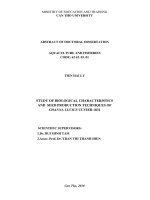

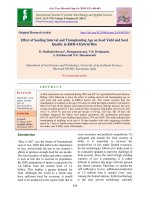
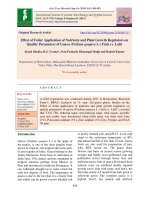
![Mapping of quantitative trait loci (QTLS) associated with sugarcane aphids resistance in recombinant inbreed population of sorghum [Sorghum bicolor (L.) Moench]](https://media.store123doc.com/images/document/2020_01/09/medium_jrk1578566578.jpg)
![Effect of precision farming techniques involving fertigation and mulching on growth attributes and seed yield of okra var. Arka Anamika [Abelmoschus esculentus (L.) Moench]](https://media.store123doc.com/images/document/2020_01/14/medium_ynr1578936108.jpg)
